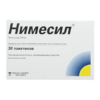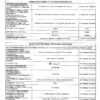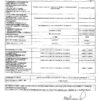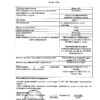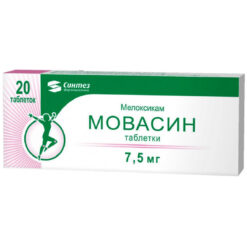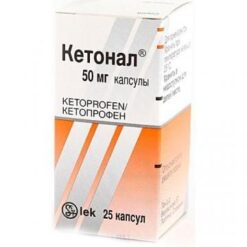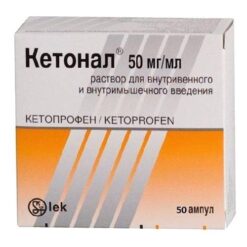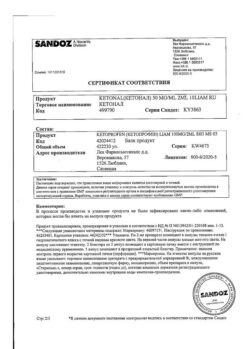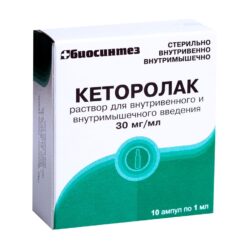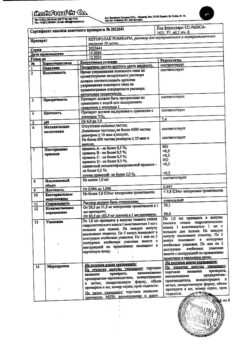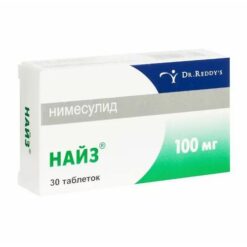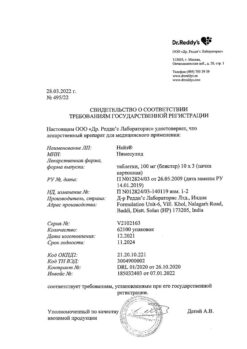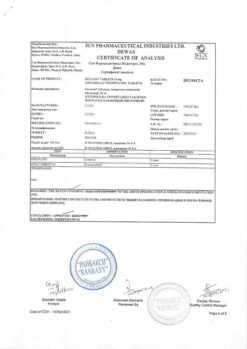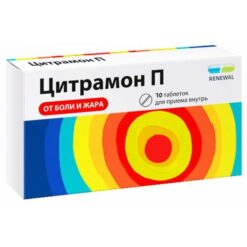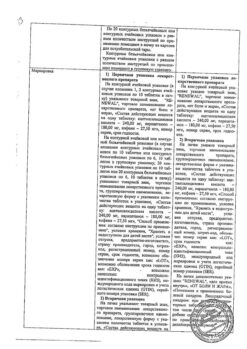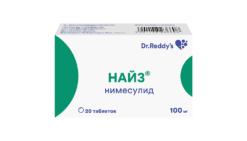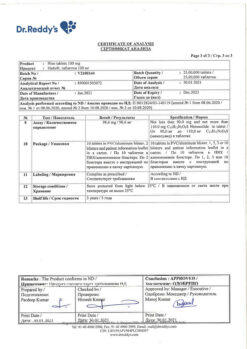No products in the cart.
Nimesil, 100 mg 2 g 30 pcs.
€36.96 €30.80
Description
Pharmacodynamics
A nonsteroidal anti-inflammatory drug of the sulfonamide class. It has anti-inflammatory, analgesic and antipyretic effect.
Nimesulide acts as an inhibitor of cyclooxygenase enzyme, which is responsible for the synthesis of prostaglandins, and inhibits mainly cyclooxygenase-2.
Pharmacokinetics
After oral administration, the drug is well absorbed from the gastrointestinal tract, reaching Cmax in plasma after 2-3 h. Binding to plasma proteins is 97.5%. T1/2 is 3.2-6 hours. Easily penetrates through histohematic barriers.
Metabolized in the liver with the help of cytochrome P450 isoenzyme (CYP) 2C9. The main metabolite is pharmacologically active parahydroxy derivative of nimesulide – hydroxynimesulide.
Hydroxynimesulide is excreted with bile in metabolized form (found exclusively as glucuronate – about 29%).
Nimesulide is excreted from the body mainly by the kidneys (about 50% of the dose taken). Pharmacokinetic profile of nimesulide in elderly persons does not change when administering single and multiple/repeated doses.
According to the experimental study conducted with the participation of patients with mild to moderate renal impairment (CK 30-80 ml/min) and healthy volunteers, Cmax of nimesulide and its metabolite in plasma of patients did not exceed the concentration of nimesulide in healthy volunteers. AUC and T1/2 in patients with renal insufficiency were 50% higher, but within pharmacokinetic values. No cumulation was observed with repeated administration of the drug.
Indications
Indications
– treatment of acute pain (back pain, lower back pain; pain syndrome in the musculoskeletal system, including injuries, sprains and dislocations of joints, tendonitis, bursitis, toothache);
– symptomatic treatment of osteoarthritis with pain syndrome;
– algodismenorrhea.
The drug is intended for symptomatic therapy, reducing pain and inflammation at the time of use.
Pharmacological effect
Pharmacological effect
Pharmacodynamics
Non-steroidal anti-inflammatory drug from the sulfonamide class. It has anti-inflammatory, analgesic and antipyretic effects.
Nimesulide acts as an inhibitor of the cyclooxygenase enzyme responsible for the synthesis of prostaglandins and inhibits mainly cyclooxygenase-2.
Pharmacokinetics
After oral administration, the drug is well absorbed from the gastrointestinal tract, reaching Cmax in the blood plasma after 2-3 hours. Plasma protein binding is 97.5%. T1/2 is 3.2-6 hours. Easily penetrates histohematic barriers.
Metabolized in the liver using the cytochrome P450 (CYP) 2C9 isoenzyme. The main metabolite is the pharmacologically active parahydroxy derivative of nimesulide – hydroxynimesulide.
Hydroxynimesulide is excreted in the bile in a metabolized form (found exclusively in the form of glucuronate – about 29%).
Nimesulide is excreted from the body, mainly by the kidneys (about 50% of the dose taken). The pharmacokinetic profile of nimesulide in elderly people does not change when administered single and multiple/repeated doses.
According to an experimental study conducted in patients with mild to moderate renal failure (creatinine clearance 30-80 ml/min) and healthy volunteers, the Cmax of nimesulide and its metabolite in the plasma of patients did not exceed the concentration of nimesulide in healthy volunteers. AUC and T1/2 in patients with renal failure were 50% higher, but within the pharmacokinetic range. With repeated administration of the drug, accumulation is not observed.
Special instructions
Special instructions
Undesirable side effects can be minimized by using the minimum effective dose of the drug for the shortest possible short course.
Nimesil should be used with caution in patients with a history of gastrointestinal diseases (ulcerative colitis, Crohn’s disease), since exacerbation of these diseases is possible.
The risk of gastrointestinal bleeding, ulceration or perforation of an ulcer increases with increasing dose of NSAIDs in patients with a history of ulcers, especially those complicated by bleeding or perforation, and in elderly patients, so treatment should be started with the lowest possible dose. Patients receiving drugs that reduce blood clotting or inhibit platelet aggregation also have an increased risk of gastrointestinal bleeding.
If gastrointestinal bleeding or ulcers occur in patients taking Nimesil, treatment with the drug should be discontinued.
Since Nimesil is partially excreted by the kidneys, its dosage for patients with impaired renal function should be reduced, depending on the level of urination.
There is evidence of rare cases of liver reactions. If signs of liver damage appear (itching, yellowing of the skin, nausea, vomiting, abdominal pain, dark urine, increased activity of liver transaminases), you should stop taking the drug and consult your doctor.
Despite the rarity of visual impairment in patients taking nimesulide concomitantly with other NSAIDs, treatment should be stopped immediately. If any visual disturbance occurs, the patient should be examined by an ophthalmologist.
The drug can cause fluid retention in tissues, so patients with high blood pressure and cardiac problems should use Nimesil with extreme caution.
In patients with renal or heart failure, Nimesil should be used with caution, as renal function may deteriorate. If the condition worsens, treatment with Nimesil should be stopped.
Clinical studies and epidemiological data suggest that NSAIDs, especially at high doses and when used for long periods of time, may lead to a small risk of myocardial infarction or stroke. There is insufficient data to exclude the risk of such events when using nimesulide.
The drug contains sucrose, this should be taken into account by patients suffering from diabetes mellitus (0.15-0.18 XE per 100 mg of the drug) and those on a low-calorie diet. Nimesil is not recommended for use in patients with rare hereditary diseases of fructose intolerance, glucose-galactose malabsorption or sucrose-isomaltose deficiency.
If signs of a “cold” or acute respiratory viral infection occur during treatment with Nimesil, the drug should be discontinued.
Nimesil should not be used simultaneously with other NSAIDs.
Nimesulide can change the properties of platelets, so caution must be exercised when using the drug in people with hemorrhagic diathesis, however, the drug does not replace the preventive effect of acetylsalicylic acid in cardiovascular diseases.
Elderly patients are especially susceptible to adverse reactions to NSAIDs, including life-threatening gastrointestinal bleeding and perforation, deterioration of renal, liver and cardiac function. When taking the drug Nimesil for this category of patients, proper clinical monitoring is necessary.
Like other drugs of the NSAID class that inhibit the synthesis of prostaglandins, nimesulide can adversely affect the course of pregnancy and/or the development of the embryo and can lead to premature closure of the ductus arteriosus, hypertension in the pulmonary artery system, impaired renal function, which can develop into renal failure with oligodyramnia, an increased risk of bleeding, decreased contractility of the uterus, and the occurrence of peripheral edema. In this regard, nimesulide is contraindicated during pregnancy and lactation. The use of the drug Nimesil can negatively affect female fertility and is not recommended for women planning pregnancy. When planning a pregnancy, consultation with your doctor is necessary.
There is evidence of the occurrence in rare cases of skin reactions (such as exfoliative dermatitis, Stevens-Johnson syndrome, toxic epidermal necrolysis) to nimesulide as well as to other NSAIDs.
At the first signs of a skin rash, damage to the mucous membranes or other signs of an allergic reaction, Nimesil should be discontinued.
Impact on the ability to drive vehicles and other mechanisms that require increased concentration
The effect of the drug Nimesil on the ability to drive vehicles and operate machinery has not been studied, therefore, during treatment with the drug Nimesil, caution should be exercised when driving vehicles and engaging in potentially hazardous activities that require increased concentration and speed of psychomotor reactions.
Active ingredient
Active ingredient
Nimesulide
Composition
Composition
Active ingredient:
nimesulide 100 mg.
Excipients:
ketomacrogol 1000,
sucrose,
maltodextrin,
anhydrous citric acid,
orange flavor.
Pregnancy
Pregnancy
Like other drugs of the NSAID class that inhibit the synthesis of prostaglandins, nimesulide can adversely affect the course of pregnancy and/or the development of the embryo and can lead to premature closure of the ductus arteriosus, hypertension in the pulmonary artery system, impaired renal function, which can develop into renal failure with oligodyramnia, an increased risk of bleeding, decreased contractility of the uterus, and the occurrence of peripheral edema.
In this regard, the drug is contraindicated during pregnancy and breastfeeding.
Contraindications
Contraindications
– severe renal dysfunction;
– erosive and ulcerative lesions of the stomach;
– hypersensitivity to the drug Nimesil.
Side Effects
Side Effects
From the hematopoietic system: rarely – anemia, eosinophilia, hemorrhagic syndrome; very rarely – thrombocytopenia, pacytopenia, thrombocytopenic purpura.
Allergic reactions: uncommon – itching, rash, increased sweating; rarely – hypersensitivity reactions, erythema, dermatitis; very rarely – anaphylactoid reactions, urticaria, angioedema, erythema multiforme, Stevens-Johnson syndrome, toxic epidermal necrolysis (Lyell’s syndrome).
From the side of the central nervous system: infrequently – dizziness; rarely – a feeling of fear, nervousness, nightmares; very rarely – headache, drowsiness, encephalopathy (Reye’s syndrome).
From the organ of vision: rarely – blurred vision.
From the cardiovascular system: infrequently – arterial hypertension, tachycardia, lability of blood pressure, hot flashes.
From the respiratory system: infrequently – shortness of breath; very rarely – exacerbation of bronchial asthma, bronchospasm.
From the digestive system: often – diarrhea, nausea, vomiting; infrequently – constipation, flatulence, gastritis; very rarely – abdominal pain, dyspepsia, stomatitis, tarry stools, gastrointestinal bleeding, ulcer and/or perforation of the stomach or duodenum; very rarely – hepatitis, fulminant hepatitis, jaundice, cholestasis, increased activity of liver enzymes.
From the urinary system: rarely – dysuria, hematuria, urinary retention; very rarely – renal failure, oliguria, interstitial nephritis.
General disorders: rarely – malaise, asthenia; very rarely – hypothermia.
Other: rarely – hyperkalemia.
Interaction
Interaction
Pharmacodynamic interactions:
When used together with glucocorticosteroids, the risk of gastrointestinal ulcers or bleeding increases.
When used together with antiplatelet agents and selective serotonin reuptake inhibitors (SSRIs), such as fluoxetine, the risk of gastrointestinal bleeding increases.
NSAIDs may enhance the effect of anticoagulants such as warfarin. Due to the increased risk of bleeding, this combination is not recommended and is contraindicated in patients with severe coagulation disorders. If combination therapy cannot be avoided, careful monitoring of blood clotting parameters is necessary.
Diuretics: NSAIDs may reduce the effect of diuretics.
In healthy volunteers, nimesulide temporarily reduces the excretion of sodium under the influence of furosemide, to a lesser extent the excretion of potassium, and reduces the diuretic effect itself.
Co-administration of nimesulide and furosemide leads to a decrease (by approximately 20%) in the area under the concentration-time curve (AUC) and a decrease in the cumulative excretion of furosemide without changing the renal clearance of furosemide.
Co-administration of furosemide and nimesulide requires caution in patients with impaired renal and cardiac function.
ACE inhibitors and angiotensin II receptor antagonists: NSAIDs may reduce the effect of antihypertensive drugs. In patients with mild to moderate renal failure (creatinine clearance 30-80 ml/min), when co-administered with ACE inhibitors, angiotensin II receptor antagonists or substances that suppress the cycloxygenase system (NSAIDs, antiplatelet agents), further deterioration of renal function and the occurrence of acute renal failure, which is usually reversible, is possible. These interactions should be taken into account in patients taking Nimesil in combination with ACE inhibitors or angiotensin II receptor antagonists. Therefore, coadministration of these drugs should be used with caution, especially in elderly patients.
Patients should be kept adequately hydrated and renal function should be closely monitored after initiating concomitant therapy.
Pharmacokinetic interactions with other drugs:
There is evidence that NSAIDs reduce the clearance of lithium, which leads to increased plasma lithium concentrations and its toxicity.
When prescribing nimesulide to patients receiving lithium therapy, plasma lithium concentrations should be regularly monitored.
No clinically significant interactions were observed with glibenclamide, theophylline, digoxin, cimetidine and antacid drugs (for example, a combination of aluminum and magnesium hydroxides).
Nimesulide inhibits the activity of the CYP2C9 isoenzyme. When taking drugs that are substrates of this enzyme with nimesulide, the concentration of these drugs in plasma may increase.
When prescribing nimesulide less than 24 hours before or after taking methotrexate, caution is required, since in such cases the plasma level of methotrexate and, accordingly, the toxic effects of this drug may increase.
Due to their effect on renal prostaglandins, inhibitors of prostaglandin synthetase, such as nimesulide, may increase the nephrotoxicity of cyclosporines.
Interaction of other drugs with nimesulide:
In vitro studies have shown that nimesulide is displaced from binding sites by tolbutamide, salicylic acid and valproic acid. Although these interactions were determined in blood plasma, these effects were not observed during clinical use of the drug.
Overdose
Overdose
Symptoms: apathy, drowsiness, nausea, vomiting, pain in the epigastric region.
With maintenance therapy for gastropathy, these symptoms are usually reversible. Gastrointestinal bleeding may occur. In rare cases, increased blood pressure, acute renal failure, respiratory depression and coma, and anaphylactoid reactions are possible.
Treatment: carry out symptomatic therapy. There is no specific antidote. If an overdose has occurred within the last 4 hours, it is necessary to induce vomiting and/or provide activated carbon (adults from 60 to 100 g) and/or an osmotic laxative. Forced diuresis and hemodialysis are ineffective due to the high binding of the drug to proteins (up to 97.5%). Monitoring of kidney and liver function is indicated.
Storage conditions
Storage conditions
Store in a dry place, protected from light and out of reach of children, at a temperature not exceeding 25 °C.
Shelf life
Shelf life
2 years.
Manufacturer
Manufacturer
Laboratorios Menarini S.A., Spain
Additional information
| Shelf life | 2 years. |
|---|---|
| Conditions of storage | Store in a dry, protected from light and out of the reach of children at a temperature not exceeding 25 ° C. |
| Manufacturer | Laboratorios Menarini S.A., Spain |
| Medication form | granules for preparation of oral suspension |
| Brand | Laboratorios Menarini S.A. |
Related products
Buy Nimesil, 100 mg 2 g 30 pcs. with delivery to USA, UK, Europe and over 120 other countries.





